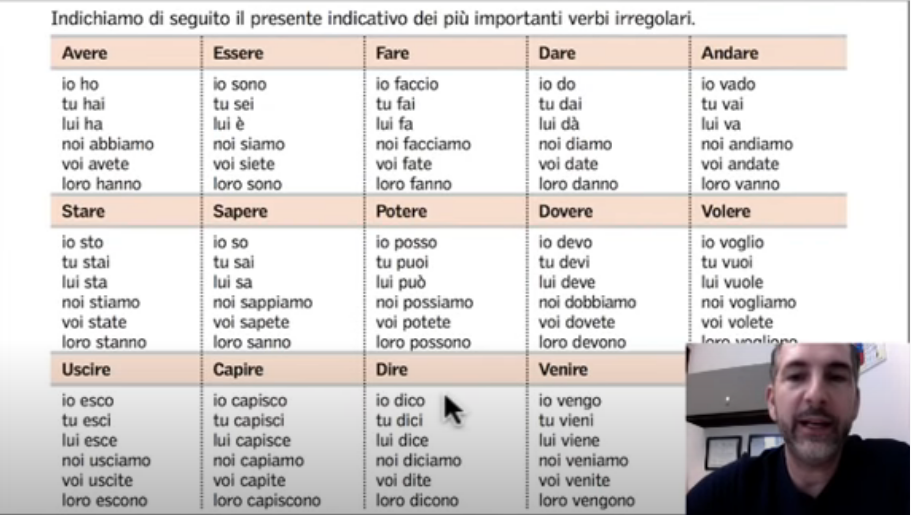Italian Verb Conjugation — 21 Ways to Do It Like an Italian Boss
Ciao a tutti! Siete pronti per un po' di studio?
Today, as Italian language learners, you're going to journey into learning how to conjugate Italian verbs!
This topic might be daunting to think about, but don't worry! While some dedicated language learners tend to become over excited and try to learn all the verb tenses and conjugations at once, we're going to start out slow and steady.
Don't feel bad if it takes some extra time and practice before you're able to remember all the conjugation patterns there are in Italian. Even native speakers have trouble sometimes when they have to correctly conjugate a different verb form than they're used to! In fact, take a look at this video by LearnAmo where they give the audience of both native and non-native Italian speakers a little verb conjugation quiz because it's such a broad topic!

Ah, le coniugazioni dei verbi a volte possono essere un vero incubo. 00:12-01:00
If you're ready to start learning how to conjugate like un Italiano vero e proprio then stick around! We'll be visiting our brava Maestra and her studente simpatico Riley on this leg of our journey into the Italian language, the verb conjugation edition!
Pronti, e via!
Italian Verb Conjugations, Where Do You Even Begin?!
- Riley! Buongiorno! Come stai?
- Maestra, I've barely finished my cappuccino, I'm too tired to speak Italian yet.
- Well, you better wake up! Today we're going to learn something molto, ma molto exciting!
- Oh, no...
- "Oh no", cosa, scusa?
- Whenever you say something's going to be exciting, that usually means it's going to be difficult.
- Riley, that's the best part! Once you've got the hang of something difficult, everything easier seems like a breeze, and you'll feel that way after you've learned what we're going to be covering today. Do you want to guess what it is?
- Um... food? We're going to just eat yummy Italian food???
- Non questa volta, Riley. We're going to cover the basics so you can start conjugating Italian verbs!
- I like my idea better.
- Riley, dai, it's not that bad! Okay, first of all, do you know what it means to conjugate verbs?
- Urgh...
- I'll give you a hint. You do it all the time!
- ... Uhh...
- Oh, Riley. It's easy! Conjugating verbs is simply the way you change a verb to reflect what the subject and verb tense of your sentence are. You might have heard the concept referred to as "subject-verb agreement" when you were in school.
- That's what that's called?
- Yes! See? It's not so hard so far. Now onto the slightly more complicated part. Do you know how many Italian verb tenses there are?
- Like three?
- Close! 21!
- Okay, I'm quitting Italian. Thanks for your time, maestra.
- Wait, wait, wait! Italian grammar likes to be difficult for foreign language learning. But don't panic, Riley! We won't learn all of those verb tenses today! Most of the time, in an actual Italian conversation, you'll be sticking with just a few verb tenses and some pretty basic conjugations. Though, if you want to challenge yourself early, here's a place where you can try to make sense of the Italian subjunctive...
- No, no! Just a few conjugations are fine... but when you say "a few", exactly how many are we talking about?
- Two... maybe three at the most! And those are the ones we'll start taking a look at today. That's not so bad, right? Just a few verb tenses out of the entire Italian language?
- I'm going to have to be up all night so I can study verb conjugations, aren't I?
- If you want to learn Italian, you have to study, Riley. That way you can make the conjugations stick in your head. Now, just pay attention, we're going to be covering:
- Italian pronouns
- The verb essere
- The verb avere
- Verb groups and verbs in their infinitive form
- The present tense
- The present perfect
- The imperfect tense
- That's entirely too many things.
- Good thing you had your caffeine fix, then, right?
FAQ: How do you memorize Italian verbs?
To memorize verbs in Italian, the easiest thing to do is to learn the ausiliari (auxiliary verbs) first as they're the most used. Next, work on memorizing the patterns regular verbs follow. Finally, work on learning a few irregular verbs at a time. Over time, you'll have them all memorized.
Look Who's Talking: Italian Pronouns
- Okay, Riley. Before you can practice Italian verb conjugation, you need to have the basic Italian pronouns covered. Any idea why?
- Uh, because you like making learning Italian difficult?
- Zitto. No. When you're speaking, most of the time you'll be using verbs in your sentences, right?
- I guess I kinda have to.
- Well, while it would be technically correct to say people's names over and over "Riley said this", "Luca ran here" etc... you'd run into a few problems.
- Yeah, who talks about themselves in the third person?
- That's one problem! Esatto!
- Did I actually get it right?!
- Yes! So, if you only said people's names for the subject of your phrases, you'd be stuck using the third-person subject all the time. But also, it would just sound funny in spoken Italian. So, you use pronouns: I, you, he/she, we, and they. All we're covering in this section is how to say those pronouns in Italian.
- I feel like there's a catch...
- No catch, Riley! Te lo prometto.
| English Pronoun | Italian Pronoun | |
| 1st person Singular | I | io |
| 2nd person Singular | You | tu |
| 3rd person Singular | He/She/You (formal) | lui/lei/Lei |
| 1st person Plural | We | noi |
| 2nd person Plural | You ("you guys") | voi |
| 3rd person Plural | They | loro |
- See, Riley? Simple!
- I mean...I guess...but there's no "it"?
- Nì.
- Maestra, what do you mean nì?
- Well, Riley, in English you use "It" for objects and other things that aren't alive, right?
- ...Are you saying everything is alive in Italian?!?!
- Don't be stupidino, Riley. No. However, in Italian everything is either "he" or "she" so there's no neutral term for things.
- Okay, but you didn't say "no" you said that... other thing.
- Nì. Which means neither yes nor no. There aren't any neutral terms for "it" but you can say "esso" or "essa". Those both work if you're talking about something that isn't alive, but they depend on the "gender" of the object you're talking about.
- Um... Got it. Maestra, my testa hurts.
- Riley, don't worry about it, essa and esso are important to know, but let's not drift from today's main lesson. Your Italian verbs conjugation crash course!
- Yay...
FAQ: How many words do you need to be fluent in Italian?
To be totally fluent in Italian, you'll need to know anywhere between 7,000 and 10,000 words. However, learning 1,000 words will put you at an intermediate level of Italian which should allow for a good level of conversation. It's also a good starting goal to aim for. The most important thing is to learn useful words first. That includes most used verbs, useful phrases, and, of course, pronouns.
Essere: To be, or not to be?
-Okay, Riley, we'll start out easy with one of the two most important verbs in Italian.
- You don't need to try and be suspenseful. I know we'll be covering the verb "to be".
- How do you know?!
- First verb we're taught. In every. Single. Language. Also, usually the trickiest.
- Oh Riley, don't be negative. You are correct, though, we're talking about the verb essere. It is also one of the main verbo ausiliare (auxiliary verbs), so it'll come in handy quite often.
- Okay, at least it sounds useful.
- It is, Riley! And quite simple, too! In fact, take a look at this Italian verb conjugation chart for the verb:
| io | sono | I am |
| tu | sei | You are |
| lui/lei/Lei | è | He/She/You (formal) is |
| noi | siamo | We are |
| voi | siete | You (plural) are |
| loro | sono | They are |
- If it helps, Riley, you can check out this video where we see someone use sono in a real-life setting to show how important it is.

Ragazzi, io sono gay. 00:20-00:40
- So, if I'm talking about what or how I am, I should use essere?
- Certo, Riley! And since you picked that one up so quickly, we can move right along to the next verb!
- But I just got the hang of this one!
FAQ: Which are the three most important verbs in Italian?
The three verbs you should learn first when you're learning Italian are essere (to be), avere (to have), and fare (to make/to do). Though there are many other important verbs to learn as well, those three will give you a good foundation to be able to start speaking Italian even when you're still a beginner. They're versatile and allow you to express a wide range of thoughts and feelings despite having a potentially limited vocabulary.
Avere: What will you be having?
- Alright, Riley, so we've covered one verbo ausiliare, now it's time to cover the other so we can move along in our conjugation lesson. Are you ready?
- No, but I'm sure we're going to move along anyway!
- That's right, Riley. You'll get the hang of things.
- Sure.
- So, we've covered essere. The other auxiliary verb you need to know in Italian is avere, which means "to have".
- Please tell me it's as simple as it is in English.
- Riley, Italian is a beautiful language... and it's almost never as simple as we hope.
-Thanks, Maestra, that sounds great.
- Oh, Riley, don't be so dramatic. Avere isn't as easy as "to have" in English, but it's not that complicated. Here, just look at this table so you can see how it's conjugated in the present tense.
| io | Ho | I have |
| tu | Hai | You have |
| lui/lei/Lei | Ha | He/She/You (formal) has |
| noi | Abbiamo | We have |
| voi | Avete | You (plural) have |
| loro | Hanno | They have |
To see this verb in use, here's a little video I'm sure you'll like, Riley.

Io ho un sogno. 01:22-1:30
- You know, Maestra, you might teach me really complicated stuff, but at least you always have some great videos to show me to make learning easier.
- Grazie, Riley! If you promise to pay attention through the rest of the lesson, I'll tell you all about where I've been getting these videos from!
- You've got yourself a deal!
- Perfetto, let's move on!
FAQ: What are the 100 most common Italian words?
The most popular 100 words in Italian are similar to the 100 most used words in English. The list is made up of the pronouns for example io or tu, the articles (both determinative like il or la and indeterminative like un or una), the prepositions like di or da, as well as the most used conjugations for the most used verbs, particularly the present tense of the ausiliari like essere and avere.
The Infinitive Forms -are, -ere, & -ire
- Alright, now that we've got our two ausiliari out of the way, time to move on to the good stuff, Riley. The rest of what you need to know about Italian verb conjugation.
- Are you sure you don't want to make that another lesson, Maestra?
- Oh, Riley, always wanting to take the easy way out. We'll start out easy, you'll be conjugating like a pro before you know it!
- If you say so.
- Bene, allora, cominciamo. The first thing you need to know before we get into verb conjugation rules is the infinite form. In English it would be the form "to", "to be", "to eat", things like that.
- So like, the base form of a verb?
- Esatto! Most Italian infinite forms are divided into either -are, -ere, or -ire verbs.
- Um... Maestra, I don't know what that means.
- Of course not, Riley, you're uno studente! You're still learning. Let's look at a few examples.
| Verb ending | Italian | English |
| -are | Mangiare | To Eat |
| -ere | Vendere | To Sell |
| -ire | Offrire | To Offer |
- Okay. Cool, but what's the point of this tense?
- I'm glad you asked! There are some cases and verb conjugations that require you to know the infinite form of a verb. However, for right now, you need to know about Italian infinite verbs to help you determine how you're supposed conjugate them in other tenses. That way you don't have to worry about using the wrong conjugation as much!
- Alright, Maestra so that's not that hard.
- I told you! So, now we can move right along to our first conjugation for other verbs than our ausiliari.
- Yeah! Wait... What?
FAQ: How many Italian verbs are there?
Between active and reflexive and regular and irregular, the Italian language has over 20000 verbs. However, not all these verbs are commonly used and many aren't necessary to learn right away.
Il Presente: What's happening right now?
- Allora, Riley, in English, which verb tense do you think would be the most important to learn?
- Maestra, you're the teacher. Don't tell me you forgot how to speak English!
- Riley, focus! If you had to pick a verb tense to teach someone, which one would be the most important?
- I don't know! The present, I guess?
- Good! Bravo, Riley! Il presente indicativo italiano or the Italian present indicative tense is exactly the first conjugation you should learn for most common Italian verbs. It's how you'll tell people what you're doing at the moment, but you can also get away with using it for future and past actions in typical language usage.
- Slow down, Maestra, you're getting excited and doing that talking fast thing you tend to do.
- Scusami, Riley, here, watch this video for an example. The speaker uses the present tense a lot to describe what she typically does, but also to describe what she is doing in the video, which is in the past.

E quindi vado nei social, questo il mio Tumblr, subito a darci un'occhiata. 00:20-01:00
- Are you ready to go into more details?
- Nope.
- Great! Now, I know you're probably frustrated by conjugation tables, but they're a great way to see that Italian verb conjugations follow patterns, so, try to stick with me, Riley.
- I'll try, Maestra, but no promises!
- That's all I can ask for, Riley. As I mentioned earlier, all common verbs follow verb conjugation patterns. That's the case for all tenses, but the present tense is the perfect introduction. Look at this table and see if you can spot the patterns!
| Mangiare | Vendere | Offrire | |
| io | Mangio | Vendo | Offro |
| tu | Mangi | Vendi | Offri |
| lui/lei/Lei | Mangia | Vende | Offre |
| noi | Mangiamo | Vendiamo | Offriamo |
| voi | Mangiate | Vendete | Offrite |
| loro | Mangiano | Vendono | Offrono |
- So, the conjugations are similar for all the infinite endings?
- Yes! Remember I told you that knowing a verb's infinite form will help you conjugate, now you see why! All three endings are similar, but there are some small differences between the -are and the -ere/-ire infinite endings.
- Okay, it's making sense, finally! This Italian thing isn't so difficult after all!
- Yes and no, Riley! The regular Italian verbs just need a little time. Once you learn the conjugation pattern, you're set for as many verbs as you like, as long as they're "regular".
- You keep saying regular...
- That's right, Riley. Take a deep breath, and maybe have a sip of water, because things are going to get un pochino more difficult.
- Oh, great...
FAQ: How do you know what tense to use in Italian?
The first thing to determine when you're trying to decide what Italian tense to use is whether you're talking about something in the present, past, or future. It's important to note that the present tense can be used in spoken Italian for future events that have a set date, like tomorrow or next year, especially when you're first learning.
Irregular verbs, don't let them scare you!
- Before we move on with learning about the verb conjugations we're going to cover today, we have to cover one of the most dreaded grammar topics for people trying to learn Italian: i verbi irregolari - irregular verbs.
- Irregular? Maestra, is this going to be confusing?
- Beh...
- That means yes. Go on, let's get this over with.
- Irregular verbs are all those verbs that don't follow the normal conjugation patterns of most Italian verbs in at least one conjugation. That could be because they don't fit in with one of the three infinitive forms, for example Porre (to place) which is conjugated like this in the present tense:
- io pongo
- tu poni
- lui/lei/Lei pone
- noi poniamo
- voi ponete
- loro pongono
- I thought you said all the verbs had the -are, -ere, -ire endings!
- Ti sbagli, Riley, you're mistaken, I said most verbs have one of those three endings! Which is true! Don't make that face and pay attention. We have other irregular verb types to talk about before we move on!
| Capire | Fare | |
| io | capisco | faccio |
| tu | capisci | fai |
| lui/lei/Lei | capisce | fa |
| noi | capiamo | facciamo |
| voi | capite | fate |
| loro | capiscono | fanno |
- Ugh, there are more?!
- Just a few! There are also verbs that are irregular because letters are added when they're conjugated in at least some cases. That's the case for the verbs capire (to understand) and fare (to make/do) that are conjugated like this:
-That's all, right, Maestra?
- Close, Riley. Another type of verb that will lead to an irregular conjugation is verbs that change some of their letters when they're conjugated. That's the case for verbs like andare (to go) or uscire (to go out/outside) that are conjugated like this:
| Andare | Uscire | |
| io | vado | esco |
| tu | vai | esci |
| lui/lei/Lei | va | esce |
| noi | andiamo | usciamo |
| voi | andate | uscite |
| loro | vanno | escono |
- Maestra, I'm not really seeing a pattern.
- Sorry, Riley, when you conjugate irregular verbs, you have to treat every single irregular verb like its own special case. You might be able to recognize some similarities, the io usually ends in -o, the tu in -i and so on. However, you'll just have to make sure to remember what makes each irregular verb irregular so you can conjugate it correctly.
- Maestra, that's not that encouraging!
- It just takes a little practice at first, Riley! You'll get the hang of it in no time. After all, you already got the hang of essere e avere and both of those are irregular verbs! Until it's second nature, here's a helpful video that goes over some of the most common irregular verbs.

I verbi più importanti dei verbi irregolari. 00:02-00:15
- That video made irregular verbs so much easier!
- I'm glad, Riley! So, are you ready to move on to our next conjugation?
- Lead the way, Maestra!
FAQ: Is Italian verb conjugation hard?
To English speakers, Italian verb conjugation can seem difficult. That's because there are a lot more rules and variations of verbs to remember. However, regular verbs follow patterns that are easy to remember once you get the hang of them. Irregular verbs also often follow a similar pattern, just with some little changes that take time to memorize.
Il Passato Prossimo: You did what?!
- Since we don't want you to get overwhelmed, we'll do these next two conjugations quickly, so you can start practicing as soon as you get home!
- Well...
- You have to practice if you want to sound like the native speakers, Riley.
- I know that! I was just thinking I could practice tomorrow!
- If you learn enough today, fine, otherwise make sure you practice a little right away before you forget everything. After all, conosco i miei polli.
- Then get teaching, Maestra, I'm ready to learn!
- The next tense we're going to learn about is one of the most common past tenses in the Italian language. It's called passato prossimo or "present perfect" in English and it's used to talk about things that have recently happened most often. However, you can use it as a general past tense, especially when you're just starting to learn!
- I don't think I've ever heard of that tense before.
- Ah, but you've likely used it. It's a compound tense, which means?
- Oh, I know this, I know this! ...I don't know this. What does it mean?
- It means that the tense is made up of two verbs.
- Two?! Maestra, I barely have a handle on one verb at a time!
- It's not that hard, Riley! You just need one of the ausiliari, essere or avere, conjugated in the present tense and the past participle of the main verb you want to use!
- That doesn't seem as simple as you say it is.
- It sounds a lot more difficult than it is, Riley. Here, watch this video of two women talking about something that happened in the recent past, they use the present perfect a lot.

L'hai visto? 00:00-00:15
- Did you hear the helping verbs in that video?
- I did!
- And did you notice the words that came directly after that usually ended in either -ta or -to if preceded by essere or -to if preceded by avere?
- Yes...
- Then that's the passato prossimo!
- It is?
- Yes! It's easy. For regular verbs, all you have to do is replace the -re of the infinitive form with:
| Ausiliare | -are verbs | -ere verbs | -ire verbs |
| Essere (suffix changes based on gender) | -ata/ato | -uta/uto | -ita/ito |
| Avere (suffix stays the same) | -ato | -uto | -ito |
Those new endings create the past participle of a verb. Irregular verbs can sometimes cause some trouble here as well, but, for the most part, verbs will follow this pattern!
- Okay, but how do you know which au-aus-
- Ausiliare.
- Yeah, that, how do you know which to use?
- That's a great question! Let's take a look at the general rules of thumb.
You would use avere for:
- Transitive verbs, the verbs that involve an object, like comprare.
- Some intransitive verbs, the verbs that don't involve an object, like dormire. However, some of these types of verbs use essere, so you'll need to do some memorizing.
So the end result will look something like:
| Comprare | Dormire | |
| io | ho comprato | ho dormito |
| tu | hai comprato | hai dormito |
| lui/lei/Lei | ha comprato | ha dormito |
| noi | abbiamo comprato | abbiamo dormito |
| voi | avete comprato | avete dormito |
| loro | hanno comprato | hanno dormito |
- Great, more things to remember.
- Riley, it seems like a lot, but it'll come naturally with practice. Anyway, moving on to our other helping verb.
You would use essere for:
- Most verbs that involve movement, like partire
- Verbs that talk about changes, like nascere
- Reflexive verbs, like lavarsi (Don't worry, we'll cover these later!)
- Verbs talking about a state, like how you are or where you've been, like stare.
So, the end result would conjugate like this:
| Partire | Nascere | Lavarsi | Stare | |
| io | sono partita/o | sono nata/o | mi sono lavata/o | sono stata/o |
| tu | sei partita/o | sei nata/o | ti sei lavata/o | sei stata/o |
| lui/lei/Lei | è partita/o | è nata/o | si è lavata/o | è stata/o |
| noi | siamo partite/i | siamo nate/i | ci siamo lavate/i | siamo state/i |
| voi | siete partite/i | siete nate/i | vi siete lavate/i | siete state/i |
| loro | sono partite/i | sono nate/i | si sono lavate/i | sono state/i |
- Okay, okay, so, from what I'm getting, this past thing...
- Il passato prossimo.
- Yeah, that it's not really difficult.
- Exactly! Like everything in Italian, even if it seems complicated at first, you really just need to make sure you practice a little bit. Then you'll get the hang of everything.
- That means class is over, right? I can go home to watch TV, uh, I mean, practice my Italian??
- Almost! Just one more tense to introduce you to, then you can go. Think you can manage?
- I'll try, Maestra.
FAQ: What does passato prossimo mean?
Passato prossimo means "near past". While it's not uncommon for people to use this tense for all types of past events in spoken Italian, it's typically used for recent past events.
L'Imperfetto: How to tell a story
- Okay, Riley. We're in the home stretch for today. The last conjugation we're going to go over is the imperfetto, the imperfect tense.
- Imperfect?
- Mhm! It's a past tense that's used to talk about things that used to happen in the past.
- Isn't that all past tenses?
- Close! However, while the present perfect talks about things that have happened in the past, those events typically happened one time and in a not-too-distant past. On the other hand, the imperfetto is used to talk about things that happened repeatedly or for a more extended period of time in the past.
- Maestra, things are getting complicated again!
- Sorry, Riley! There's plenty of time to go further into detail about the imperfect, but the reason why I'm bringing it up to you today is because it's often used in storytelling.
- Oh! Like in that Italian short stories lesson you had me read?
- Exactly! You'll also hear it in narration a lot. Here's a clip you probably recognize where the imperfect is used.

Mamma diceva sempre che i miracoli succedono tutti i giorni. 00:00-00:20
- Hey, I love that movie!
- I thought you'd like that clip, and knowing the dialog probably helped you figure out the past tense verbs, right?
- Yeah! Um. I think.
- Don't worry, Riley. This tense is just an introduction. To help you start learning, here are a few useful Italian verb conjugation tables so you can recognize this tense when you come across it.
FAQ: Why is it called the imperfect tense?
The imperfetto (imperfect) tense gets its name because it's used for events that aren't considered concluded. In this case, that's because it's used for actions that were done with some level of consistency.
The ausiliari
| Essere | Avere | |
| Io | ero | avevo |
| Tu | eri | avevi |
| Lui/Lei | era | aveva |
| Noi | eravamo | avevamo |
| Voi | eravate | avevate |
| Loro | erano | avevano |
- I'm noticing a lot of the letter "v" in this one, it's very, very interesting.
- Just you wait, Riley. Let's look at a few regular verbs to get an idea of the imperfect conjugation pattern.
Regular verbs & l'imperfetto
| Amare (to love) | Credere (to believe) | Sentire (to feel/hear) | |
| io | amavo | credevo | sentivo |
| tu | amavi | credevi | sentivi |
| lui/lei/Lei | amava | credeva | sentiva |
| noi | amavamo | credevamo | sentivamo |
| voi | amavate | credevate | sentivate |
| loro | amavano | credevano | sentivano |
- Do you want to know the best part, Riley?
- Huh? What?! I got distracted trying to memorize all those "v" endings.
- Even irregular verbs follow these patterns! You just have to make sure you make any changes you need to in order to conjugate, as you saw with essere and avere.
- Finally! Something simple!
Infine: Don't let the fun stop here!
- So, Riley, abbiamo finito, here we are, at the end of another lesson. Come stai?
- I'm tired! So much information packed into one little lesson!
- When it comes to verbs, it's sometimes better to jump right in, Riley. That way you have plenty of things you can practice!
- Ugh, I guess you're right. Hey! Wait! Didn't you say you would tell me where you got all our lesson videos?
- That's right, Riley! Thanks for reminding me! I found this really great site called Flying Languages.
- Flying Languages?
- Mhm! It's a language learning site that specializes in teaching through videos. There are built-in translations of all sorts of videos, most of which aren't typical teaching videos, so they're easy to watch and veramente interessanti!
- That sounds like just the sort of site I need to help me practice!
- I thought you'd think that, Riley! Since we're done for today, why don't you check it out here and you can tell me about your favorite video next time!
FAQ: What's the quickest and easiest way to learn Italian?
The quickest way to learn Italian is through full immersion. That means surrounding yourself with Italian speakers. This typically means staying in Italy for an extended period of time. Since this can be impossible for many learners, you can simulate this process by watching, listening to, and reading as many things in the Italian language as possible. You can also find Italian speakers in your city or online so you can practice your conversational skills, as well.





